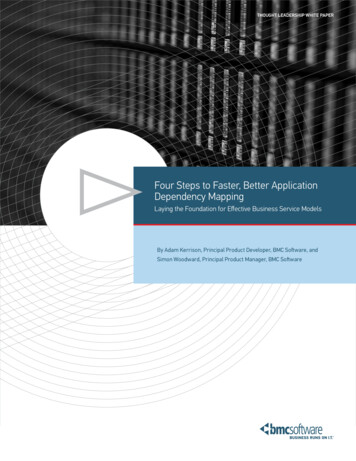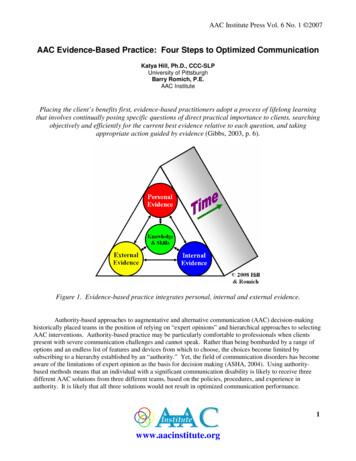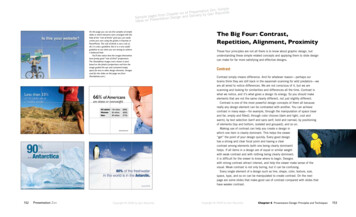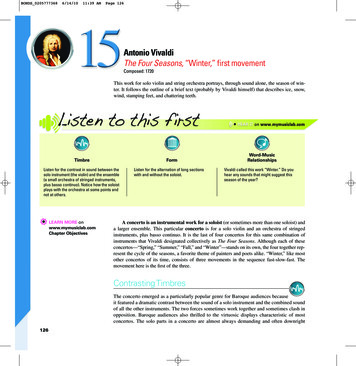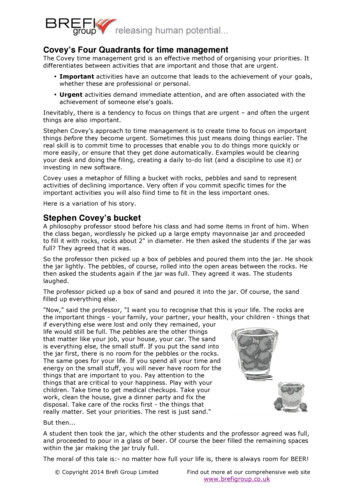
Transcription
The Four Steps tothe Epiphany
The Four Steps tothe EpiphanySuccessful Strategies forProducts that WinSteven G. BlankSecond Edition
Third Edition Copyright 2006 Steven G. BlankAll rights reserved. No part of this book may be reproduced in any form whatsoever without permission,except in case of brief quotations embodied in critical articles or reviews.Published 2006Printed by Lulu.comThird revised printing
AcknowledgmentsIn my 25 years as a technology entrepreneur I was lucky to have three extraordinary mentors, eachbrilliant in his own field: Ben Wegbreit who taught me how to think, Gordon Bell who taught mewhat to think about, and Allen Michels who showed me how to turn thinking into direct andimmediate action.I was also extremely fortunate to be working in Silicon Valley when three of its most influentialmarketing practitioners and strategists were active. As a VP of Marketing I was strongly influencedby the customer-centric books of Bill Davidow, former VP of Marketing of Intel and founder of Mohr,Davidow Ventures and consider myself fortunate to have had him on my board at MIPS Computers.Regis McKenna was already a PR and marketing legend with his own firm when I started my career,but his thinking and practice still resonates in my work. Finally, I still remember the hair rising onthe back of my neck when I first read Geoff Moore and the notion of a “chasm.” It was the first time Irealized that there were repeatable patterns of business behavior that could explain the heretoforeunexplainable.At U.C. Berkeley Haas Business School, Jerry Engel, director of the Lester Center onEntrepreneurship, was courageous enough to give me a forum to test and teach the CustomerDevelopment Methodology to hundreds of unsuspecting students. Professor John Freeman at Haashas offered valuable insight on the different sales cycles by Market Type. Finally my long-sufferingteaching partner at Haas, Rob Majteles, ensured that not only did my students get my enthusiasm,but also got a coherent syllabus and their papers graded and back on time. At Stanford, Tom Byers,Mark Leslie, Audrey Maclean and Mike Lyons were gracious enough to invite me to teach with themin the Graduate School of Engineering and hone my methodology as they offered additional insightson new product selling cycles. Finally, Columbia Business School allowed me to inflict the courseand this text on their students in their joint MBA program with the Haas Business school.In the venture capital world in addition to funding some of my startups, John Feiber at MDVand Katherine Gould at Foundation Capital have acted as stalwart sounding boards and supporters.My friends Steve Weinstein, Bob Dorf, Bernard Fraenkel, Todd Basche and Jim Wickett havemade innumerable and valuable comments and suggestions.Will Harvey and Eric Ries of IMVU were the first corporate guinea pigs to implement some or allof the Customer Development Methodology. This book was required reading for every new hire attheir company. Fred Durham at CafePress allowed me to sit on his board and watch a world-classentrepreneur at work.Besides running engineering at IMVU Eric Ries also moonlighted as copyeditor and helpedeliminate the embarrassing typos of the first revision.This book would be much poorer without all of their contributions.Finally, my wife Alison Elliott not only put up with my obsession with finding a methodology forearly stage Customer Development, and my passion for teaching it, she added her wise counsel,insight and clarity to my thinking. This book would not have happened without her.Acknowledgments i
Table of ContentsACKNOWLEDGMENTSITHE HERO’S JOURNEYiiiWINNERS AND LOSERSVCHAPTER 1 THE PATH TO DISASTER: THE PRODUCT DEVELOPMENT MODEL1CHAPTER 2 THE PATH TO EPIPHANY: THE CUSTOMER DEVELOPMENT MODEL15CHAPTER 3 CUSTOMER DISCOVERY27CHAPTER 4 CUSTOMER VALIDATION67CHAPTER 5 CUSTOMER CREATION101CHAPTER 6 COMPANY BUILDING133BIBLIOGRAPHY171APPENDIX A CUSTOMER DEVELOPMENT TEAM175APPENDIX B CUSTOMER DEVELOPMENT CHECKLIST181ABOUT THE AUTHOR231
PrefaceThe Hero’s JourneyA legendary hero is usually the founder of something—the founder of a new age, the founderof a new religion, the founder of a new city, the founder of a new way of life. In order to found somethingnew, one has to leave the old and go on a quest of the seed idea, a germinal ideathat will have the potential of bringing forth that new thing.— Joseph Campbell, Hero with a Thousand FacesJoseph Campbell popularized the notion of an archetypal journey that recurs in the mythologies andreligions of cultures around the world. From Moses and the burning bush to Luke Skywalkermeeting Obi wan Kenobi, the journey always begins with a hero who hears a calling to a quest. Atthe outset of the voyage, the path is unclear, and the end is not in sight. Each hero meets a uniqueset of obstacles, yet Campbell’s keen insight was that the outline of these stories was always thesame. There were not a thousand different heroes, but one hero with a thousand faces.The hero’s journey is an apt way to think of startups. All new companies and new products beginwith an almost mythological vision–a hope of what could be, with a goal that few others can see. It’sthis bright and burning vision that differentiates the entrepreneur from big company CEOs andstartups from existing businesses. Founding entrepreneurs are out to prove that their vision andbusiness are real and not some hallucination; to succeed they must abandon the status quo andstrike out on what appears to be a new path, often shrouded in uncertainty. Obstacles, hardshipsand disaster lie ahead, and their journey to success tests more than financial resources. It tests theirstamina, agility, and the limits of courage.Most entrepreneurs feel their journey is unique. Yet what Campbell perceived about themythological hero’s journey is true of startups as well: however dissimilar the stories may be indetail, their outline is always the same. Most entrepreneurs travel down the startup path without aroadmap and believe that no model or template could apply to their new venture. They are wrong.For the path of a startup is well worn, and well understood. The secret is that no one has written itdown.Those of us who are serial entrepreneurs have followed our own hero’s journey and takenemployees and investors with us. Along the way we’ve done things our own way; taking good advice,bad advice, and no advice. On about the fifth or sixth startup, at least some of us began to recognizethat there was an emerging pattern between our successes and failures. Namely, that there is a trueand repeatable path to success, a path that eliminates or mitigates the most egregious risks andallows the company to grow into a large, successful enterprise. One of us decided to chart this pathin the following pages.Discovering the Path”Customer Development” was born during my time spent consulting for the two venture capital firmswho between them put 12 million into my last failed startup. (My mother kept asking if they weregoing to make me pay the money back. When I told her they not only didn’t want it back, but weretrying to see if they could give me more for my next company, she paused for a long while and thensaid in a very Russian accent, “Only in America are the streets paved with gold.”) Both venture firmssought my advice for their portfolio companies. Surprisingly, I enjoyed seeing other startups from anoutsider’s perspective. To everyone’s delight, I could quickly see what needed to be fixed. At aboutThe Hero’s Journey iii
the same time, two newer companies asked me to join their boards. Between the board work and theconsulting, I enjoyed my first-ever corporate “out-of-body experience.”No longer personally involved, I became a dispassionate observer. From this new vantage point Ibegan to detect something deeper than I had seen before: there seemed to be a pattern in the midstof the chaos. Arguments that I had heard at my own startups seem to be repeated at others. Thesame issues arose time and again: big company managers versus entrepreneurs, founders versusprofessional managers, engineering versus marketing, marketing versus sales, missed scheduleissues, sales missing the plan, running out of money, raising new money. I began to gain anappreciation of how world-class venture capitalists develop pattern recognition for these commontypes of problems. “Oh yes, company X, they’re having problem 343. Here are the six likely ways thatit will resolve, with these probabilities.” No one was actually quite that good, but some VCs had“golden guts” for these kinds of operating issues.Yet something in the back of my mind bothered me. If great venture capitalists could recognizeand sometimes predict the types of problems that were occurring, didn’t that mean that the problemswere structural rather than endemic? Wasn’t something fundamentally wrong with the wayeveryone organizes and manages startups? Wasn’t it possible that the problems in every startupwere somehow self-inflicted and could be ameliorated with a different structure? Yet when I talkedto my venture capital friends, they said, “Well, that’s just how startups work. We’ve managedstartups like this forever; there is no other way to manage them.”After my eighth and likely final startup, E.piphany, it became clear that there is a better a wayto manage startups. Joseph Campbell’s insight of the repeatable patterns in mythology is equallyapplicable to building a successful startup. All startups (whether a new division inside a largercorporation or in the canonical garage) follow similar patterns—a series of steps which, whenfollowed, can eliminate a lot of the early wandering in the dark. Looking back on startups that havethrived reflect this pattern again and again and again.So what is it that makes some startups successful and leaves others selling off their furniture?Simply this: startups that survive the first few tough years do not follow the traditional productcentric launch model espoused by product managers or the venture capital community. Through trialand error, hiring and firing, successful startups all invent a parallel process to product development.In particular, the winners invent and live by a process of customer learning and discovery. I call thisprocess “Customer Development,” a sibling to “Product Development,” and each and every startupthat succeeds recapitulates it, knowingly or not.This book describes the “Customer Development” model in detail. The model is a paradoxbecause it is followed by successful startups, yet articulated by no one. Its basic propositions are theantithesis of common wisdom yet they are followed by those who succeed.It is the path that is hidden in plain sight.iv The Four Steps to the Epiphany
IntroductionWinners and LosersWhat if everything you think you know about taking products to market is wrong? What would youdo differently if you realized that only 1 out of 10 new product introductions result in a profitablebusiness? Would you continue to operate the same way, week after week, year after year? Thesurprising fact is that companies large and small, established corporate giants as well as brand newstartups, fail in 9 out of 10 attempts to launch their new products. They unnecessarily burn throughbillions of dollars as they try to force their new products into markets where no one is waiting to buy.Yet time and again they all return to the same processes that produce failure.The phenomenon occurs over and over again in every product category, whether high tech, lowtech, consumer products, or business-to-business products. Some new product disasters have becomethe stuff of legend: Volkswagen Phaeton. Volkswagen took all of Toyota’s lessons in launching it’s high-endLexus brand and ignored them. Cost to date: 500 million Kodak’s Photo CD. Kodak offered film camera customers the ability to put their pictures ona compact disc and view them on their TV’s. It was 10 years ahead of its time and marketedto customers who were not ready for it. Viable early adopter market in corporate marketingdepartments ignored. Cost: 150 Million Segway. Thought their market was everyone in the world who walked and confused worldclass public relations with customers with checkbooks. Still searching for their real markets.Cost to date: 200 million. Apple’s Newton. They were right about the Personal Digital Assistant market but five yearstoo soon. Yet they spent like they were in an existing market. Cost: 100 Million Jaguar X-Type. Created a Ford-type, low-end product and slapped the Jag name on it,alienating their high-end customers. Cost: 200 million Webvan. Groceries on demand: the killer app of the internet. The company spent money likea drunken sailor. Even in the Internet Bubble costs and infrastructure grew faster than thecustomer base. Loss: 800 million. Sony’s MiniDisc players. A smaller version of the CD wildly popular in Japan. The US isn’tJapan. Cost to date: 500 million after 10 years of marketing. R.J. Reynolds’ Premier and Eclipse smokeless cigarettes. Understood what the generalpublic (nonsmokers) wanted, but did not understand that their customers didn’t care. Cost: 450 million Motorola’s Iridium satellite-based phone system. Engineering triumph and built to supporta customer base of millions. No one asked the customer if they wanted it. Cost 5 billion.Yes, billion. Satellites are awfully expensive.I could go on and on. And you probably have your own favorites you could add to the list. Whatif I told you that such disasters can be avoided? What if I told you that there are new productintroduction methods available that dramatically increase the odds of a new product finding a home-- and at a minimum that guarantee that there will be a ready, willing, and paying customer basejust waiting to get their hands on that new, new thing being lovingly grown in the R& D greenhouse?The methods I’m advocating in this book -- are easily explained and understood, but they runcounter to the way most companies operate. There aren’t many managers around who are willing toreject the conventional wisdom that guides most firms in their quest to take new products to market.Those managers and entrepreneurs who do follow this different path find that there are eagercustomers for their products.To name a few who did it right in their recent, very successful product launches:Winners and Losers v
Proctor & Gamble’s Swiffer. A swiveling, disposable mop-on-a-stick. Sophisticated planningand consumer research have resulted in a 2.1 billion market in 2003 that could double by2008.Toyota’s Prius. They’ve found a profitable niche for their electric hybrid car. As a classicdisruptive innovation, sales will grow and Toyota will continue to eat the existing US carcompanies for lunch. In its first five years sales grew to 5 billion. By 2015 hybrids couldmake up 35% of U.S. car market.General Mills’ Yoplait GoGurt. Yogurt in a tube. The goal was to keep their yogurtconsumer base of toddlers and little kids for as long as possible. Research led to the tubepackaging, making yogurt easier to consume on the go.The Difference between the Winners and LosersEvery company has some methodology for product development, launch and life-cycle management.These processes provide detailed plans, checkpoints and goals for every step in getting a product outthe door; sizing markets, estimating sales, developing marketing requirements documents,prioritizing product features. Yet at the end of the day even with all these procedures theembarrassing fact is that 9 out of 10 of new products are failures.The difference between the winners and losers is simple.Products developed with seniormanagement out in front of customers early and often - win. Products handed off to a sales andmarketing organization that has only been tangentially involved in the new product developmentprocess lose. It’s that simple.The reality for most companies today is that existing product introduction methodologies arefocused on activities that go on inside a company own building. While customer input may be acheckpoint or “gate” in the process it doesn’t drive it.This book is not another set of product development processes that are simple extensions of whatalready exists. New product mortality rates tell us that doesn’t work; the emperor simply has noclothes. Existing new product launch processes don’t offer prediction and guidance of customerbehavior, therefore we need to build a new set of product development processes that will.What this book offers is a radical reexamination of the entire new product introduction process.It makes clear that companies need a parallel process to product development; one dedicated tobringing customers and their needs head first into the new product introduction process – before theproduct is ever launched or shipped.The lesson is clear: by listening to potential future customers’, by going out into the field andinvestigating potential customers needs and markets before being inexorably committed to a specificpath and precise product specs – the difference between the winners and losers – and that’s theCustomer Development Process described in this book.Who Is This Book For?When I first started writing this book, I thought its audience would be small and its applicabilitywould be narrow. I first believed that my readers would be startup entrepreneurs.With this audience in mind, I went out to talk to venture capital firms and their portfoliocompany startups to test the Customer Development concepts. Many of these startups were past the“we’re just starting out” stage. At first, I thought the Customer Development model might beinteresting reading for them, but not particularly germane to CEOs and other executives who werein the midst of building a company. This group had real day-to-day operational problems to solve,and the last thing on their minds was to read some abstruse text about what they should have donelast year. But the more I talked to these startups and spent time understanding their issues, themore I realized that they were all under pressure to solve a common set of problems: Where is ourmarket? Who are our customers? How do we build the right team? How do we scale sales? Theseissues are at the heart of the Customer Development methodology.vi The Four Steps to the Epiphany
Not surprisingly, there is a large body of literature on the success and failure of new products inlarge companies. The more I read and then talked to large corporations, the more I became convincedthat the Customer Development model is even more applicable to existing companies attempting tolaunch new products into new markets. The challenge of understanding customers and finding amarket is the same for a large company as for a startup. But large companies have established welldefined processes and procedures that are the antithesis of the Customer Development model. Inother words, the guidelines for starting a new product in a new market are the antithesis of the wellhoned rules observed by large and successful enterprises. Indeed, those rules are a recipe for failurewhen it comes to a startup-like initiative. The cost of launching new products into new markets canexceed the absolute dollars a startup spends by several orders of magnitude. While the expectedreturns are huge, making these type of mistakes in a large company can be catastrophic.Finally, I had found my audience for this book: any team launching a new product, from a smallentrepreneurial startup to a large corporation. This book is not just for the CEO but all executivesand employees of early stage ventures; it’s for all the founders, the engineers, the VP of Sales, the VPof Marketing, etc. – anyone who is struggling to come up with answers on how to find customers andmarkets. This book will help all of you to bring rigor to the Customer Development Process.Throughout this book, I use the terms entrepreneur and startup quite liberally. The termsencompass the brave souls in Fortune 1000 companies just as much as they describe three teensstarting in a garage.This or any road map will only take you where you want to go if you have the discipline to followit, together with the vision and passion that characterize the best entrepreneurs. As with greatartists, these are innate qualities that make successful serial entrepreneurs a rare breed. Relentlessexecution is also something that is hard to get from a book. It is best learned by being thrown out ofthe offices of countless prospective customers as you try to learn what appeals to them. It meansgetting off the floor and going back to a customer who said “no” and finding out how to turn that intoa “yes.”This book will point the way. Completing your own hero’s journey is up to you.Who Is This Book Not For?There are cases where using the Customer Development methodology is inappropriate. Thereare businesses where the aphorism “build and they will come” is actually true. For example, inbiotechnology startups, if you could can find a drug which cures a specific cancer, a CustomerDevelopment strategy is simply a waste of time; it doesn’t take a formal process to figure out thatthere will be huge end user demand for the drug.The risk in biotechnology companies is in the front-end of product development; taking aresearch hypothesis and developing into a successful and effective drug, not in the back-end ofcustomer acceptance and adoption. In a biotechnology startup success and failure are not aboutunderstanding customer needs or adoption. If the company can develop a product that works andget it through the FDA approval process, customers would literally be dying to get it.In these companies to get to a Phase III trial (for Controlled Safety and Efficacy, the last stepbefore submitting a New Drug Application to the FDA), a company has typically spent four and ahalf years in clinical trials and nearly 50 million. For these ventures, the issue isn’t CustomerDevelopment to understand end user needs, but rather finding the right Partner, Licensing andDistribution Channel strategies.Similar issues can be found in some health care and energy products. The users and markets areknown and if a product can development business is assured. However, our contention is that in thepast, most entrepreneurs in every early stage venture believed that “build it and they will come”described their company. Our contention is that it only covers the few, not the many.For the rest of us, where the issues are customer acceptance and market adoption, this bookshows the path.Winners and Losers vii
Chapter 1The Path to Disaster:The Product Development Model“ for the gate is wide and the road broad that leads to destruction, and thosewho enter through it are many.”— Matthew 7:13Every traveler starts a journey faced with the decision of what road to take. The road well traveledseems like the obvious choice. The same is true in the search for startup success: following a path ofcommon wisdom – one taken by scores of startups before, seems like the right way. Yet the adviceoffered two thousand years ago is relevant for startups today, namely that the wide road often leadsstraight to disaster. How and why this is so is the subject of this chapter.Let me begin with a cautionary tale. In the heyday of the dot-com bubble, Webvan stood out asone of the most electrifying new startups, with an idea that would potentially touch every household.Raising one of the largest financial war chests ever seen (over 800 million in private and publiccapital), the company aimed to revolutionize the 450 billion retail grocery business with onlineordering and same-day delivery of household groceries. Webvan believed this was a “killerapplication” for the Internet. No longer would people have to leave their homes to shop. They couldjust point, click, and order. Webvan’s CEO told ForbesT magazine that Webvan would “set the rulesfor the largest consumer sector in the economy.”Besides amassing megabucks, the Webvan entrepreneurs seemed to do everything right. Thecompany raced to build vast automated warehouses and purchased fleets of delivery trucks, whilebuilding an easy-to-use web site. Webvan hired a seasoned CEO from the consulting industry,backed by experienced venture capital investors. What’s more, most of their initial customersactually liked their service. Barely 24 months after the initial public offering, Webvan was bankruptand out of business. What happened?It wasn’t a failure of execution. Webvan did everything its board and investors asked. Inparticular, the company fervently followed the traditional product development model commonlyused by startups, including “get big fast,” the mantra of the time. Webvan management followed theproduct development model religiously. Its failure to ask “Where Are the Customers?” illuminateshow a tried-and-true model can lead even the best-funded, best-managed startup to disaster.THE PRODUCT DEVELOPMENT DIAGRAMEvery company bringing a new product to market uses some form of Product Development Model.(Figure 1.1)Emerging early in the twentieth century, this product-centric model described aprocess that evolved in manufacturing industries. It was adopted by the consumer packaged goodsindustry in the 1950s and spread to the technology business in the last quarter of the twentiethcentury. It has become an integral part of startup culture.At first glance, the diagram appears helpful and benign, illustrating the process of getting a newproduct into the hands of waiting customers. Ironically, the model is a good fit when launching anew product into an established, well-defined market where the basis of competition is understood,and its customers are known.The irony is that few startups fit these criteria. Few even know what their market is. Yet theypersist in using the product development model not only to manage product development, but as aroad map for finding customers and to time their sales launch and revenue plan. The model hasChapter 1: The Path to Disaster 1
become a catchall tool for every startup executive’s schedule, plan, and budget. Investors use theproduct development diagram to set and plan funding. Everyone involved uses a road map that wasdesigned for a very different location, yet they are surprised when they end up aunch/1st ShipFigure 1.1 The Product Development DiagramTo see what’s wrong with using the product development model as a guide to building a startup,let’s first look at how the model is currently used to launch a new product. We’ll view the actions ateach step in two ways: in general practice and in the specific example of Webvan, which managed toburn through 800 million in 3 years. Then we will dissect the model’s toxic consequences forstartups.What’s wrong with the old model in general, and how were those wrongs compounded in thebillion-dollar Webvan implosion? Lets look at the model stage-by-stage.Concept and Seed StageIn the Concept and Seed Stage, founders capture their passion and vision for the company and turnthem into a set of key ideas, which quickly becomes a business plan, sometimes on the back of theproverbial napkin. The first thing captured and wrestled to paper is the company’s vision.Next, issues surrounding the product need to be defined: What is the product or service concept?Is it possible to build? Is further technical research needed to ensure that the product can be built?What are the product features and benefits?Second, who will the customers be and where will they be found? Statistical and market researchdata plus potential customer interviews determine whether the ideas have merit.Step three probes how the product will ultimately reach the customer and the potentialdistribution channel. At this stage that companies start thinking about who their competitors are,and how they differ. They draw their first positioning chart and use it to explain the company and itsbenefits to venture capitalists.The distribution discussion leads to some basic assumptions about pricing. Combined withproduct costs, an engineering budget, and schedules, this results in a spreadsheet that faintlyresembles the first financial plan in the company’s business plan. If the startup is to be backed byventure capitalists, the financial model has to be alluring as well as believable. If it’s a new divisioninside a larger company, forecasts talk about return on investment. Creative writing, passion, andshoe leather combine in this concept and seed phase in hopes of convincing an investor to fund thecompany or the new division.Webvan did all of this extremely well. Founded in December 1996, with a compelling story, and afounder with a track record, Webvan raised 10 million from leading Silicon Valley venturecapitalists in 1997. In the next two years, additional private rounds totaling an unbelievable 393million would follow before the company’s IPO (initial public offering).Product DevelopmentIn stage two, product development, everyone stops talking and starts working. The respectivedepartments go to their virtual corners as the company begins to specialize by functions.Engineering focuses on building the product; it designs the product, specifies the first releaseand hires a staff to build the product. It takes the simple box labeled “product development” andmakes detailed critical path method charts, with key milestones. With that information in hand,Engineering estimates delivery dates and development costs.2 The Four Steps to the Epiphany
Meanwhile, Marketing refines the size of the market defined in the business plan (a market is aset of companies with common attributes), and begins to target the first customers. In a wellorganized startup (one with a fondness for process) the marketing folk might even run a focus groupor two on the market they think they are in and prep
My friends Steve Weinstein, Bob Dorf, Bernard Fraenkel, Todd Basche and Jim Wickett have made innumerable and valuable comments and suggestions. Will Harvey and Eric Ries of IMVU were the first corporate guinea pigs to implement some or all of the Customer Development Methodology. This book
